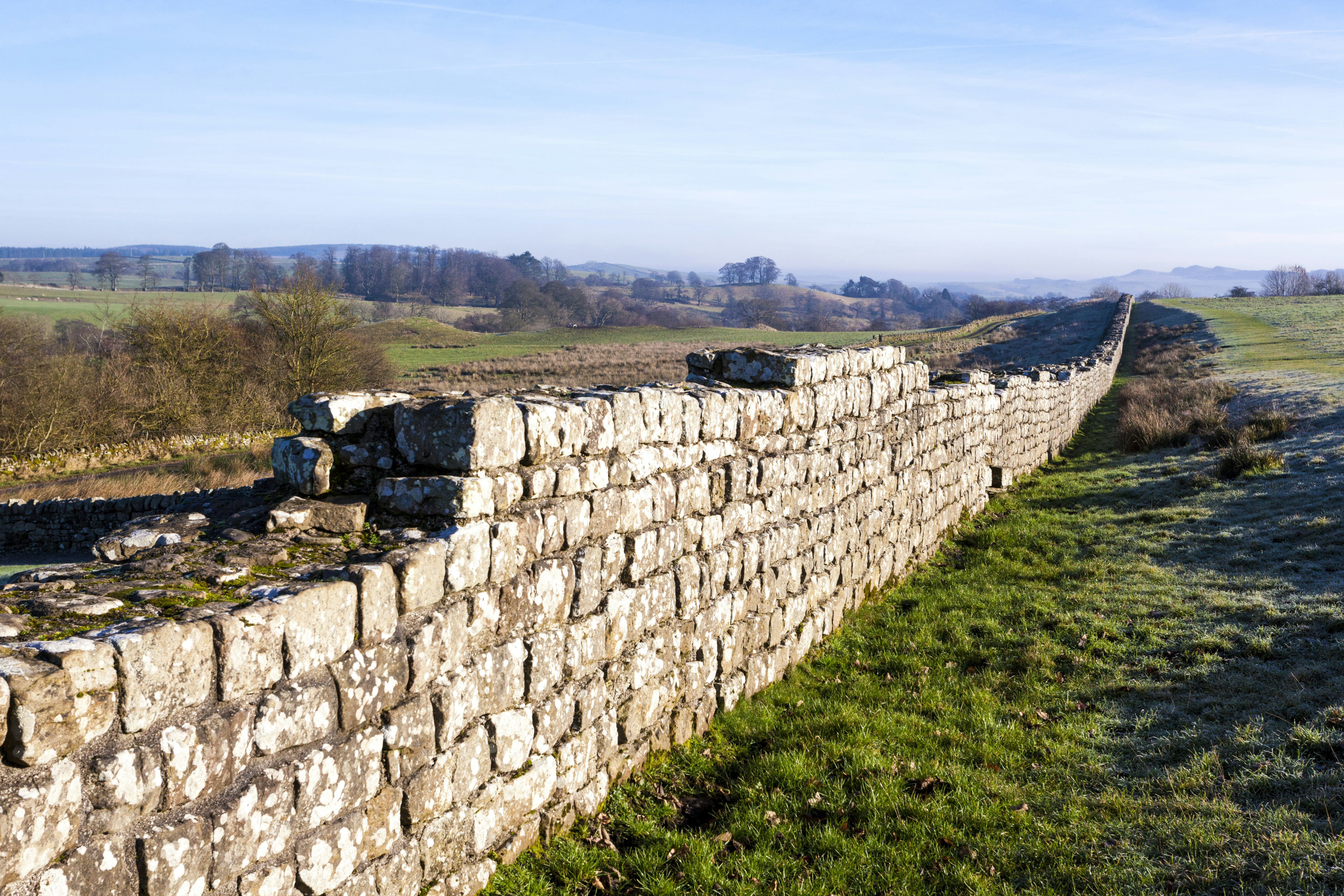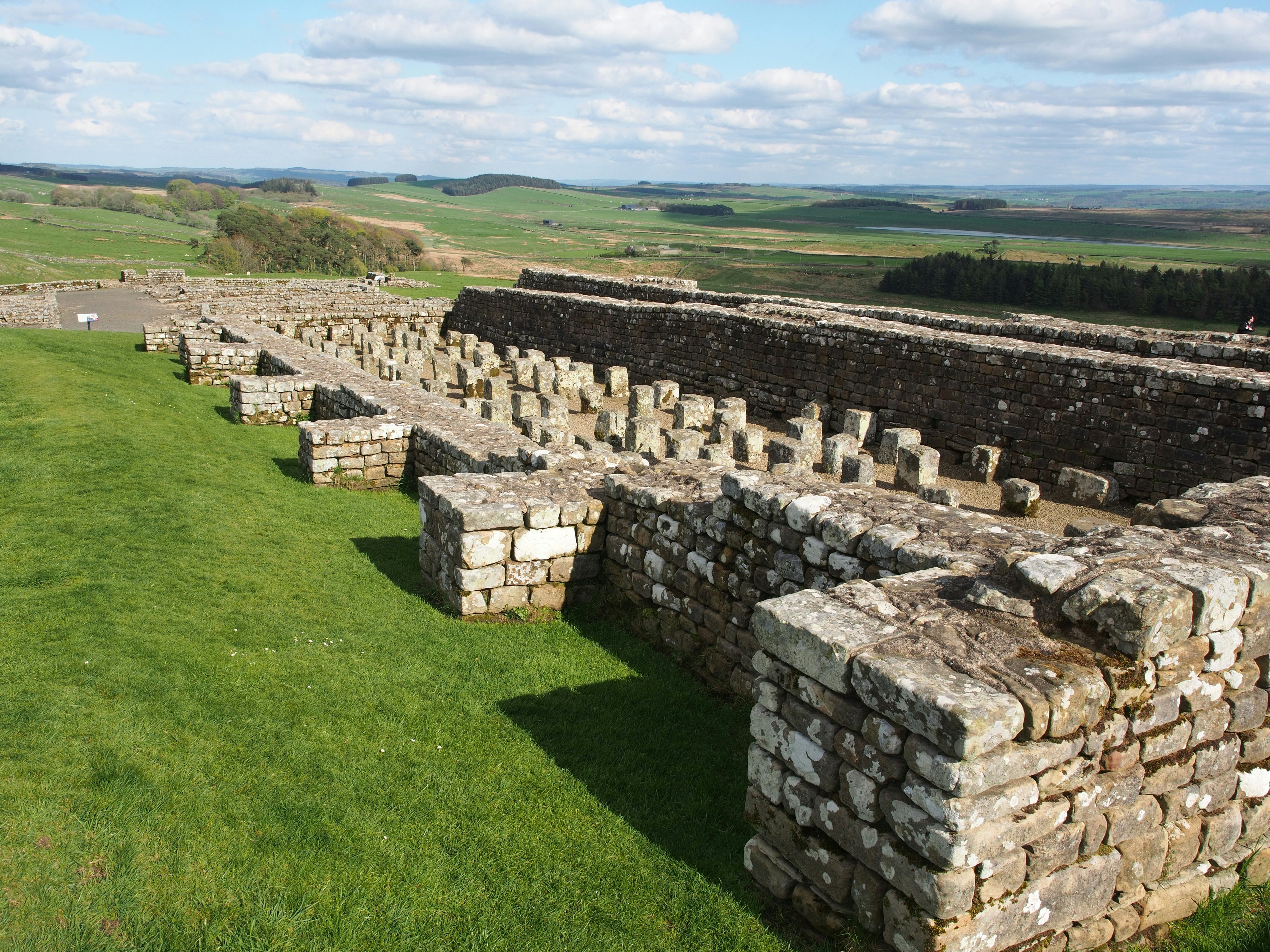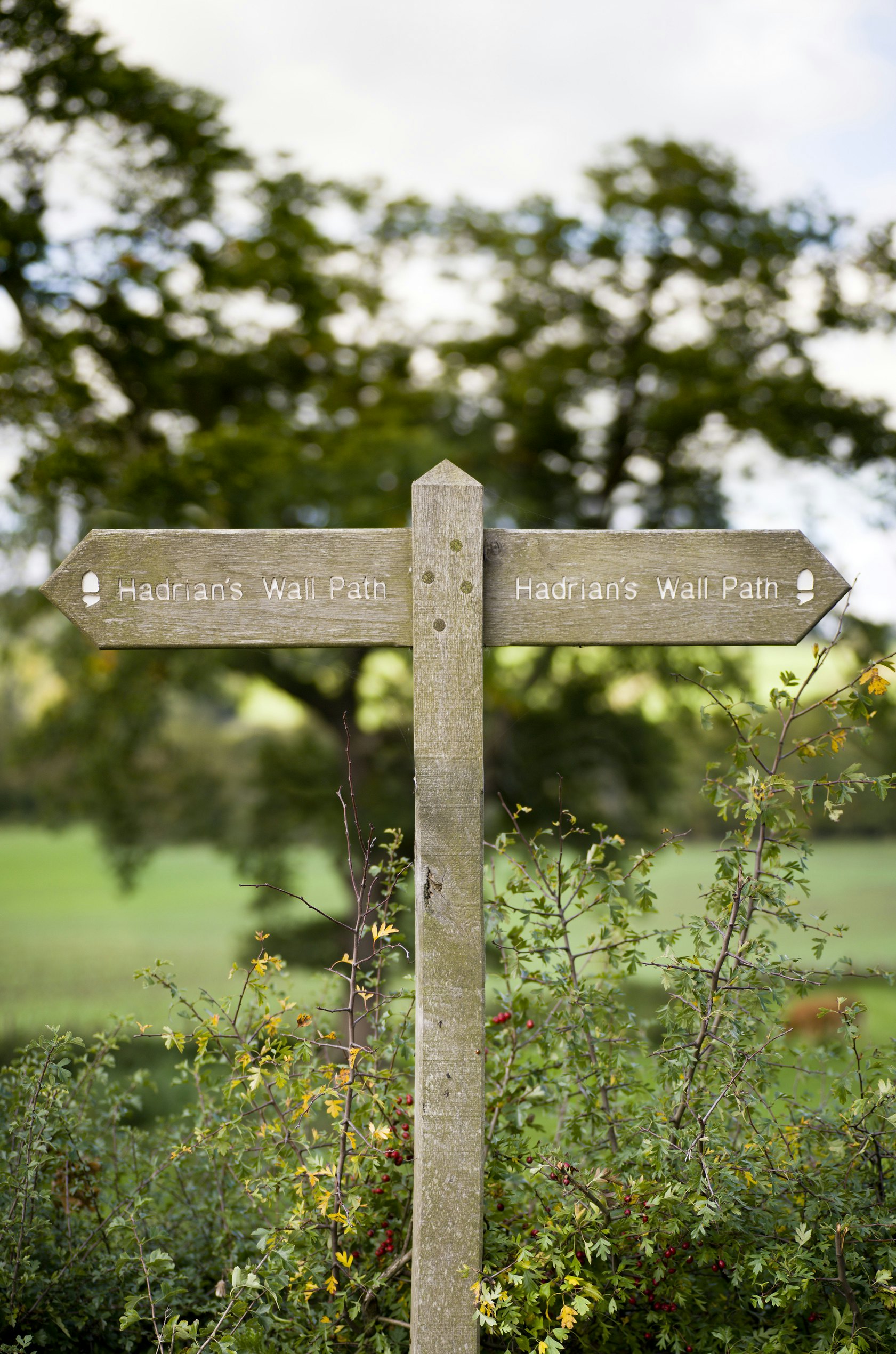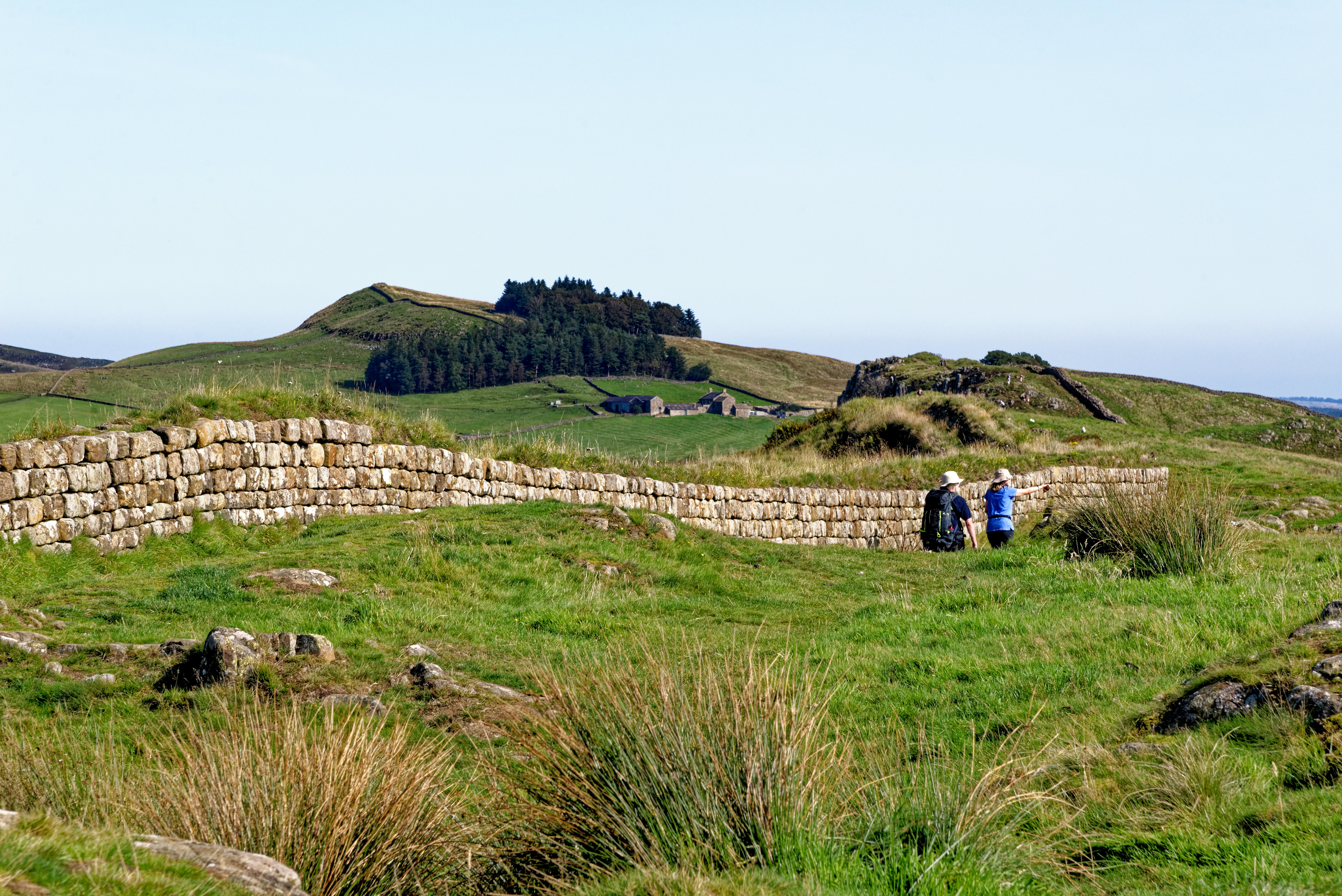
Hadrian's Wall near Crag Lough. Duncan Andison/Getty Images
Once the northern frontier of the Roman Empire, Hadrian’s Wall remains one of the world’s most remarkable ruins: a crumbling symbol of the fallen power, architectural ingenuity and military might of ancient Rome. The Hadrian’s Wall Path, a UK National Trail, runs for 84 miles (135km) across most of northern England, from Wallsend in the east to Bowness-on-Solway in the west, allowing you to hike coast to coast alongside this remarkable relic.
The original wall stands in varying states of deterioration. The whole thing is buried beneath grass in spots; at other locations, the foundations are revealed. On the long stretches where the wall is well-preserved, the trail resounds with echoes of the past. At places like Housesteads and Vindolanda, the wall meets the ruins of once-mighty fortifications, with the remains of barracks, bathrooms and grain stores making it easy to imagine to what life was like for the people here 2000 years ago.
Combined with the spectacular scenery of this part of England – the rolling hills, rugged fells and craggy escarpments of Cumbria and Northumberland – the route is one of Great Britain’s most rewarding and atmospheric walks. I'm lucky enough to live in northern England, so I never miss the chance to pull on my boots and tramp a stretch of Hadrian’s Wall.

What is the history of Hadrian’s Wall?
It’s hard to believe, given what a peaceful place it is today, but when the Romans were consolidating their power over the island in the 1st and 2nd centuries CE, this was a battleground. The Roman armies were met with fierce resistance when they tried to invade Scotland on several occasions. In 122 CE, Emperor Hadrian visited Britannia, as Rome’s British province was known, and ordered the construction of a great wall that would demonstrate imperial strength, provide a base for further military excursions north of the border and protect against raids from the Scottish lowlands.
Over the next six years, the wall was built, reaching 4.5m (15ft) high and 3m (9ft) thick, punctuated every 7 miles (11 km) or so with forts that sheltered 600 soldiers. Smaller forts were situated every few miles along the wall. It’s believed up to 10,000 soldiers in total were garrisoned along Hadrian’s Wall – an awesome show of military strength.

What are the major sights along Hadrian’s Wall?
One of the great draws of Hadrian’s Wall is the variety of sights you’ll encounter as you walk along it. Walking east to west, it begins (appropriately enough) at Wallsend, and the museum at the well-preserved ruins of the Roman fort of Segedunum illuminates what life would have been like for the soldiers posted here.
An urban stretch follows through the heart of Newcastle-upon-Tyne, one of the country’s friendliest and most vibrant cities. It’s worth lingering here to admire the Tyne Bridge, explore the BALTIC – Centre for Contemporary Art and enjoy lunch at Grainger Market – your last taste of modern city life for quite some time.
Moving west, the trail passes through the rolling countryside of Northumberland, following the foundations of the wall to more remnant forts at Chesters and Housesteads. The latter was the largest settlement along the wall, and the remains of latrines, barracks and houses are in evidence. The green landscape becomes less gently pastoral and more dramatic at this juncture, with the wall running along the top of Whin Sill, a dramatic plateau dominated by views of the soaring Pennine Hills.
For centuries, one of the most iconic sights along Hadrian’s Wall was Sycamore Gap, a dip between two hills in which there grew a famous sycamore tree, popular with walkers and photographers for its perfect symmetry. The tree achieved international renown when it was featured in the 1991 film Robin Hood: Prince of Thieves. The tree was illegally felled in October 2023, but it survived, and new shoots can already be seen growing from its stump – meaning a visit to the tree, while not as much of a photo opportunity as it once was, remains an inspiring and poignant experience.

What do I need to know before I walk Hadrian’s Wall?
As with all long-distance walking trails, planning is key. The first thing to decide is whether you wish to take on the whole Hadrian’s Wall Path in one go – a great adventure that takes most walkers around a week. Next, you’ll need to decide which direction you want to walk. Most walkers go from east to west for two main reasons. The first is that walking in this direction means you’ll begin in the urban environment of Newcastle and walk out into the countryside, which sets the tone for the bucolic atmosphere of the route. The second is that facing west means you have a beautiful sunset to look forward to at the end of each day – or on those days that the weather plays ball, at least.
On the other hand, one advantage of going in the other direction is that the prevailing wind tends to be from west to east, so you’ll normally have the breeze at your back, instead of blowing into your face – potentially a major improvement on the more exposed upland sections.
Whatever direction you go and no matter the time of year, weather is the top consideration – this is northern England we’re talking about, after all. Rain is a possibility in all seasons, and waterproof layers are essential (including pants), along with blister plasters and a sturdy pair of walking boots.

Where can I stay along Hadrian’s Wall?
If you’re after an immersive countryside stay but can’t quite bring yourself to camp, try Octagon Hut, a lovely glamping cabin in a private meadow close to the town of Hexham and just a few minutes’ walk from the wall. The outdoor kitchen and campfire are particularly lovely on a summer’s evening, while the woodburning stove is very welcome on wetter, chillier days.
Lots of lovely B&Bs are set up along the route too, like the cozy Brookside Villa B&B near the village of Gilsland. This place caters to walkers, with drying facilities and fast laundry services for those wet boots and dirty clothes.
If you’re camping, there are dozens of sites where you can pitch a tent for a small fee, including the Hadrian’s Wall Campsite at Melkridge and Bleatarn Farm Campsite near Carlisle.
Where are there places to eat and drink along Hadrian’s Wall?
Hiking the span of Britain is hungry and thirsty work, but plenty of cafes, pubs and restaurants can help you relax and refuel, from the tempting homemade cakes and sandwiches at Sill to the beautiful country food at Gilsland’s Samson Inn. Keep an eye out on menus for Cumberland sausages and Northumberland kippers (smoked herring), both regional specialities.
A classic British afternoon tea awaits at Lanercost Tea Rooms, outside the ruins of Lanercost Priory, east of Carlisle, while if you’re looking to really treat yourself, Michelin-starred Hjem in the village of Wall combines Scandinavian cooking techniques with Northumbrian produce.
If you’re in the market for a well-earned beer, stop in the Twice Brewed Inn, where home-brewed beers are served alongside hearty pub grub: steak and ale pie, bangers and mash, juicy beef burgers and the like. The village of Twice Brewed is one of the curiosities along the wall – it has a split personality. Arriving from the east, road signs tell you it’s called Once Brewed; arriving from the west, it’s known as Twice Brewed.





